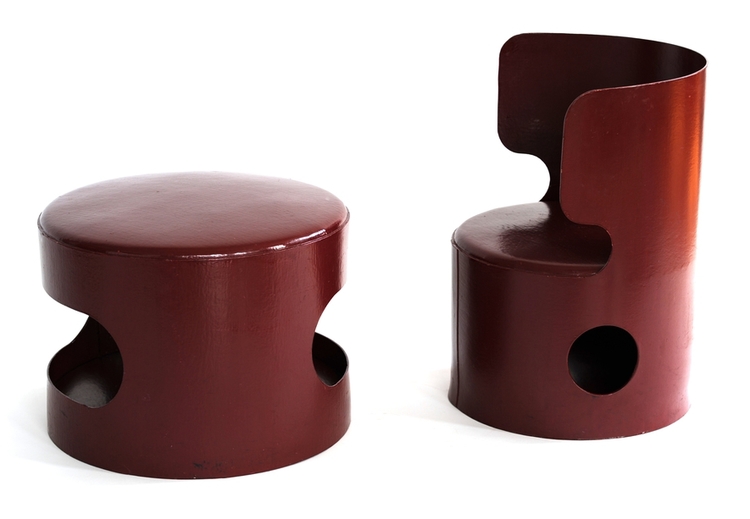002. MATERIALITY
PLASTICS AND THE CHANGING MIDCENTURY
Written by Frances Vigna
For years, parents have relied on plastic products to simplify raising a child, and with good reason. Synthetic plastics, according to design critic and historian Peter Fiell, have numerous child-friendly properties, including durability and ease of maintenance. But it wasn’t until the middle of the last century that plastics, thanks to advancements in materials and manufacturing technology, became affordable for daily use. Manufacturers of the period capitalized on the rise of small-space living by producing children’s designs that could be adapted for home, school, and play. Plastics in products expressly for children, from a Noguchi-designed baby monitor to a 1969 ergonomic bathtub and training potty, revolutionized child-rearing for the modern family.
The postwar baby boom and housing shortage made inexpensive space-saving furniture necessary, and manufacturers appealed to parents of young children by producing pieces serving multiple purposes. In the early sixties, Walter Papst and Dieter Thern exploited the versatility of plastic in a single-seat construction with bases that could be reconfigured to serve a child’s needs (a mass-production concept Charles and Ray Eames introduced earlier with the PAW shell chair, the first design to utilize the preform method of reinforced-plastic molding). The plastic convertible child's chair with a tubular steel base, designed by Papst and Thern and produced by the German industrial-design firm Wilkhahn, could be modified into a swing, rocker, or high chair with only a few additional components. British designer Robin Day also developed mass-produced chairs that cleaned and stacked easily, ideal for public spaces such as elementary schools. His injection-molded shell chair in lightweight polypropylene suited children at any level of physical ability. Featuring a cutout handle and available in five sizes, the Series E polyprop chair was and is easy to maneuver and remains a staple in British schools.
Industrial designers soon saw the potential of advanced manufacturing technology in developing safe, durable furniture from a single synthetic material. In 1963, Kartell, an Italian company already producing plastics for automobile manufacturing, founded its Habitat division for furniture design. A year later, Marco Zanuso, along with Richard Sapper, produced the K 4999 children’s chair. The chair was constructed from high-density polyethylene, an inexpensive semirigid plastic, in bright, playful colors. “All toy manufacturers know that children are attracted to bright colors, so it is not surprising that children’s furniture is generally brightly colored,” Fiell says. Luckily, according to Fiell, it is easier for manufacturers to impregnate plastic with dye than to apply paint to its surface. This technique produces a more durable color and also increases safety, as there is no paint for children to pick off and ingest.
The malleability of new plastics released midcentury designers from the limitations of older materials and allowed for greater inventiveness in children's furniture. To encourage creative play, the legs of the K 4999 chair could be removed from the slatted back and the parts rearranged like building blocks. In 1979, Kartell’s in-house design team, Centrokappa, produced the Sistema Scuola, a colorful modular system with chair, table, and divider parts that children could use, as with the K 4999 chair, to build forts. Walter Papst designed plastic children’s toys in modernist shapes utilizing state-of-the-art manufacturing processes and materials. The German designer used the strong yet lightweight glass-reinforced polyester (also known as fiberglass) to advantage when developing toys to inspire creativity. His Rocking Sculpture features an abstract red fiberglass base and only small references to the traditional rocking horse, such as a few strands of black “tail,” allowing children to complete the design with their imagination.
As manufacturing technology improved through the years, industrial designers became better able to create single-material, single-form furniture uniquely for children. Most often, designers created children’s furniture as adult styles in miniature, which ultimately did not serve a child’s particular needs. In the late seventies, French designer Marc Berthier produced a small, brightly colored desk that combined seating and work surfaces into a compact unit. The success of Berthier’s desk is due to its “child-centric design,” says Fiell, “which means it is very much child scaled.” According to Fiell, a monoblock construction “will always be the best for children’s furniture, as it does not have dirt-trap seams and its structural integrity is generally more durable.” The all-in-one OZOO mini desk, developed for Roche Bobois, was constructed from a single sheet of glass-reinforced polyester.
The most effective product design for children not only stimulates creativity but also encourages childhood development. Children’s furniture “helps engender a better learning environment as it creates a more child-friendly space,” Fiell says. “And when children feel more at home in a room, the more likely it is that they will relax and be receptive to learning.” The OZOO mini desk had safe, rounded corners and could be stacked, making it perfect for children as young as kindergarten age. The design also incorporated several integrated compartments for books and supplies, resulting in a tidy workstation promoting focused study habits.
Contemporary designs are no longer limited by the manufacturing processes of the last century. According to Fiell, product designers, using a combination of computer-modeling software and rapid-prototype technology, can mold the latest polymers into an infinite number of shapes for mass production. However, with the rising costs of petroleum and the growing amount of plastic waste, consumers are becoming more concerned about the sustainability of the material in everyday products. While no single solution for the consumption and disposal of synthetic polymers has yet been achieved, industrial designers are working with great success to establish viable alternatives to the plastics of the midcentury. Exciting new bioplastics and recycled polymers may soon be the materials of choice for children’s furniture. Along with innovative designs and manufacturing methods, sustainable plastics, like new materials of the twentieth century, will no doubt transform current parenting practices.









